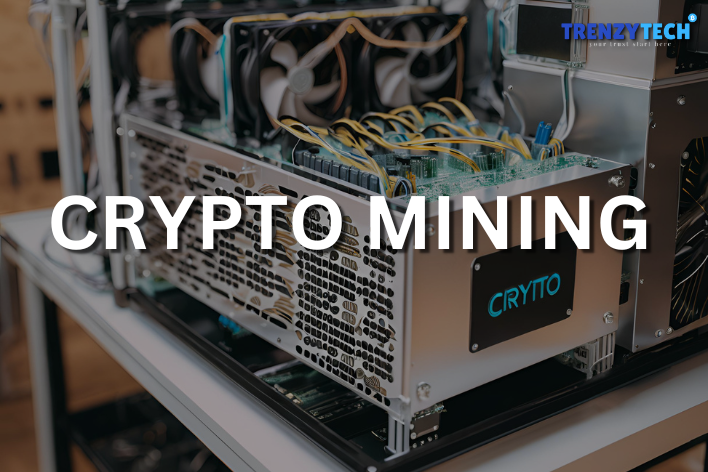From Small-Scale to Industrial: Stories of Crypto Mining Growth
Introduction:
Cryptocurrency mining has come a long way since the early days of Bitcoin. What started as a niche hobby for tech enthusiasts has transformed into a major global industry. Today, mining operations range from small home setups to massive industrial-scale facilities, each contributing to the intricate network that powers digital currencies. This blog post will explore the fascinating journey of crypto mining, from its humble beginnings to its current state, and highlight the stories of miners who have successfully navigated this dynamic landscape. Through their experiences, we will uncover the strategies, challenges, and innovations that have shaped the evolution of cryptocurrency mining.
The Early Days of Bitcoin Mining:
In the early days, mining Bitcoin was relatively simple and could be done using standard personal computers. enthusiasts often mined as a hobby, using CPU power to solve cryptographic puzzles. These pioneers laid the foundation for what would become a massive industry.
Satoshi Nakamoto: On January 3, 2009, Bitcoin's pseudonymous creator, Satoshi Nakamoto, mined the first block of Bitcoin, known as ‘’The Genesis Block’’. This block contained a hidden message in its coinbase data: "The Times 03/Jan/2009 Chancellor on brink of second bailout for banks," a reference to a headline from The Times newspaper. This message has been interpreted as a critique of the traditional banking system and a statement of Bitcoin's purpose as an alternative form of money.
Laszlo Hanyecz: On May 22, 2010, Laszlo Hanyecz made history by conducting the first known real-world Bitcoin transaction. He paid 10,000 BTC for two pizzas, a transaction that has since become legendary and is celebrated annually as Bitcoin Pizza Day. At the time, the transaction was a fun experiment, but it demonstrated Bitcoin's potential as a medium of exchange. Today, those 10,000 BTC would be worth millions of dollars.
Transition to GPU Mining:
The shift to GPU (Graphics Processing Unit) mining marked a significant evolution in the cryptocurrency mining landscape. Here’s a concise look at this transition, its reasons, and its implications:
1. Why the Shift to GPU Mining?
Increased Efficiency:
Benefit: GPUs are more efficient than traditional CPUs (Central Processing Units) for mining cryptocurrencies, especially those like Ethereum, which benefit from parallel processing capabilities of GPUs.
Example: A single GPU can outperform a CPU in hash rate, making it more cost-effective and faster for mining operations.
Specialization:
Benefit: GPUs are specifically designed for handling repetitive and parallel tasks, which are common in mining algorithms.
Example: Cryptocurrencies like Ethereum use the Ethash algorithm, optimized for GPU performance.
2. Advantages of GPU Mining
Higher Hash Rates:
Advantage: GPUs offer higher hash rates compared to CPUs, leading to more successful mining operations.
Example: A modern GPU can achieve several hundred mega-hashes per second (MH/s), significantly more than a high-end CPU.
Versatility:
Advantage: GPUs can mine various cryptocurrencies, making them more flexible than specialized ASIC (Application-Specific Integrated Circuit) miners.
Example: GPUs can switch between mining Ethereum, Zcash, and other coins depending on profitability.
3. Challenges and Adaptations
Increased Difficulty and Competition:
Challenge: As more miners adopt GPUs, mining difficulty increases, requiring more powerful hardware and efficient setups.
Adaptation: Miners regularly upgrade their GPU rigs and optimize their setups for better performance and energy efficiency.
Heat and Power Consumption:
Challenge: GPUs generate significant heat and consume substantial power, leading to higher operational costs.
Adaptation: Miners use advanced cooling solutions and seek regions with lower electricity costs to maintain profitability.
The Rise of ASIC Miners:
As the Bitcoin network grew, so did the mining difficulty. This evolution demanded more powerful and efficient mining equipment, leading to the development and rise of Application-Specific Integrated Circuits (ASICs). Here’s a look at how ASIC miners transformed the landscape of cryptocurrency mining:
1. The Limitations of GPU Mining
Before ASICs, miners primarily used Graphics Processing Units (GPUs). While GPUs were significantly more powerful than CPUs for mining, they were still general-purpose processors. This meant they were not optimized solely for the specific tasks required in Bitcoin mining, leading to inefficiencies as the network’s difficulty increased.
Key Point: GPU mining was an improvement over CPU mining but faced challenges as Bitcoin’s popularity and mining difficulty grew.
2. The Birth of ASIC Miners
ASIC miners were designed specifically for mining cryptocurrencies, making them far more efficient than their GPU predecessors. These specialized chips could perform the SHA-256 hashing required for Bitcoin mining much faster and with less power consumption.
Key Players:
Avalon (Canaan Creative): In 2013, Canaan Creative released the first-ever Bitcoin ASIC miner, the Avalon ASIC. This marked the beginning of the shift from GPU to ASIC mining.
Bitmain: Bitmain quickly became a dominant player with their Antminer series, which offered superior performance and efficiency, solidifying their position as a leader in the mining hardware market.
3. Impact on Mining Efficiency
ASIC miners dramatically increased the efficiency and profitability of Bitcoin mining. These devices could process transactions at a much higher rate and with significantly lower energy costs compared to GPUs.
Key Developments:
Antminer S9: Released in 2016, the Antminer S9 became one of the most popular and powerful ASIC miners, boasting a hash rate of up to 14 TH/s (terahashes per second).
Technological Advancements: Over the years, ASIC technology has continued to advance, with newer models like the Antminer S19 Pro offering hash rates exceeding 100 TH/s, further pushing the boundaries of mining efficiency.
4. The Evolution of the Mining Industry
The introduction of ASIC miners marked a significant turning point in the cryptocurrency mining industry. The focus shifted to industrial-scale mining farms equipped with thousands of ASIC devices, aiming to maximize efficiency and profitability.
Case Studies:
Genesis Mining: Transitioned from small-scale GPU mining to operating large mining farms with ASIC miners.
Bitmain: Not only produced ASIC miners but also operated some of the largest mining farms globally.
Industrial Scale Mining Farms:
As cryptocurrency gained popularity, small-scale mining operations struggled to keep up with the increasing complexity and competition. This led to the rise of industrial-scale mining farms, which have fundamentally transformed the mining landscape.
1. The Concept of Mining Farms
Industrial-scale mining farms are large facilities specifically designed to house thousands of mining rigs, usually ASIC miners. These farms leverage economies of scale to maximize efficiency and profitability, often located in areas with cheap electricity and favorable climatic conditions.
Key Features:
High-Density Setup: Rows upon rows of mining rigs, meticulously arranged to optimize space and airflow.
Cooling Solutions: Advanced cooling systems, including water cooling and air conditioning, to manage the immense heat generated.
Energy Management: Utilization of renewable energy sources or regions with surplus electricity to minimize costs.
2. Leading Examples of Mining Farms
Genesis Mining:
Location: Iceland, Sweden
Overview: Genesis Mining is one of the largest and most well-known cloud mining providers. It capitalized on Iceland’s abundant geothermal energy and favorable climate to power its operations sustainably.
Impact: Demonstrated the viability of large-scale, environmentally conscious mining operations.
Bitmain:
Location: Various global locations, including China (before regulatory changes), the United States, and Europe.
Overview: Bitmain operates some of the largest mining farms globally and manufactures the highly efficient Antminer series.
Impact: Their industrial farms significantly contribute to the global hash rate, reinforcing Bitmain’s dominant position in the mining hardware market.
Hut 8 Mining:
Location: Canada
Overview: Hut 8 leverages Canada’s cold climate and inexpensive electricity to power its large-scale mining operations.
Impact: As a publicly traded company, Hut 8 provides transparency and attracts institutional investment into the mining sector.
3. Environmental and Economic Considerations
Energy Consumption:
Challenge: Industrial-scale mining farms consume vast amounts of electricity, raising concerns about environmental impact.
Solution: Increasing use of renewable energy sources, such as hydroelectric, solar, and wind power, to mitigate the carbon footprint.
Economic Impact:
Local Economies: Mining farms can stimulate local economies by creating jobs and investing in infrastructure.
Electricity Markets: Large farms can influence local electricity prices and policies, sometimes leading to tensions with local communities.
4. Future Trends in Industrial Mining
Technological Advancements:
Innovation: Continuous improvements in mining hardware and cooling technologies.
Efficiency: Development of more energy-efficient ASICs and smarter energy management systems.
Sustainability Efforts:
Green Mining: Increased focus on reducing the environmental impact of mining operations through the use of renewable energy and carbon offset programs.
Corporate Responsibility: Large mining companies adopting sustainable practices and transparency in operations to attract environmentally conscious investors.
Renewable Energy and Sustainable Mining:
As cryptocurrency mining grows, so do concerns about its environmental impact. Industrial-scale mining farms consume vast amounts of electricity, often leading to significant carbon footprints. To address this, many mining operations are turning to renewable energy sources and adopting sustainable practices. Here’s an overview of how the industry is moving towards greener mining:
1. Renewable Energy Sources
Hydroelectric Power:
Usage: Hydropower is one of the most common renewable energy sources for mining farms, particularly in regions with abundant water resources.
Examples:
Bitfarms: Located in Canada, Bitfarms uses hydroelectric power to operate its mining facilities. This reduces their carbon footprint and helps keep electricity costs low.
Sichuan Province, China: Before the crackdown on mining, many operations in Sichuan utilized the region's surplus hydropower, especially during the rainy season.
Solar Power:
Usage: Solar energy is harnessed by mining farms located in sunny regions, contributing to cleaner mining practices.
Examples:
Hut 8 Mining: Although primarily hydro-powered, Hut 8 also explores solar power to diversify its energy sources and promote sustainability.
Wind Power:
Usage: Wind energy is another renewable source used by mining operations, particularly in areas with high wind potential.
Examples:
US Mining Farms: Some U.S.-based mining operations are integrating wind power into their energy mix to reduce reliance on fossil fuels and lower operational costs.
2. Sustainable Practices
Energy Efficiency:
Optimizing Hardware: Modern ASIC miners are designed to be more energy-efficient, performing more calculations per watt of electricity.
Example: The Antminer S19 series by Bitmain offers improved energy efficiency, making it a popular choice for eco-conscious mining farms.
Heat Management:
Reusing Heat: Some mining farms are developing systems to capture and reuse the heat generated by mining rigs.
Example: In colder regions, excess heat from mining operations can be used to warm buildings or greenhouses, turning a byproduct into a useful resource.
Carbon Offsetting:
Buying Credits: Some mining companies purchase carbon credits to offset their emissions, contributing to global carbon reduction efforts.
Example: Companies like Argo Blockchain have committed to becoming carbon-neutral by buying carbon credits and investing in renewable energy projects.
3. Case Studies in Sustainable Mining
Genesis Mining:
Location: Iceland, Sweden
Sustainability Efforts: Genesis Mining uses Iceland’s geothermal and hydroelectric power, taking advantage of the country's renewable energy infrastructure and cool climate, which reduces the need for additional cooling.
Riot Blockchain:
Location: Texas, USA
Sustainability Efforts: Riot Blockchain leverages Texas' deregulated electricity market to access renewable energy sources like wind and solar, aligning their operations with sustainable practices.
Regulatory Challenges and Adaptations:
As cryptocurrency mining has grown in scale and significance, it has increasingly attracted the attention of regulators around the world. This attention has led to various regulatory challenges that mining operations must navigate. Here's an overview of the key regulatory challenges and how mining operations are adapting:
1. Government Crackdowns and Bans
China's Crackdown:
Challenge: In 2021, China intensified its crackdown on cryptocurrency mining, citing concerns about energy consumption, financial risks, and the potential for illicit activities. This led to the shutdown of numerous mining operations across the country.
Adaptation: Many Chinese miners relocated to more crypto-friendly countries such as Kazakhstan, Russia, and North America, setting up new operations in regions with supportive regulatory environments and abundant energy resources.
India's Uncertain Stance:
Challenge: India has fluctuated in its stance on cryptocurrency, with proposed bans creating uncertainty for miners. The lack of clear regulatory frameworks makes it difficult for miners to operate with confidence.
Adaptation: Miners in India have remained cautious, often operating in a semi-stealth mode or considering relocation to jurisdictions with clearer regulatory policies
2. Financial and Legal Compliance
AML/KYC Requirements:
Challenge: Anti-Money Laundering (AML) and Know Your Customer (KYC) regulations are becoming stricter, requiring mining operations to implement robust compliance frameworks.
Adaptation: Mining companies are enhancing their compliance systems, often collaborating with legal experts to ensure adherence to AML and KYC regulations. This includes rigorous customer verification processes and reporting suspicious activities.
Taxation Policies:
Challenge: The tax treatment of cryptocurrency mining varies widely by jurisdiction, creating complexity in accounting and financial reporting.
Adaptation: Mining companies are hiring specialized tax advisors to navigate the complex tax landscape. In some cases, they are lobbying for clearer tax guidelines and favorable policies to support the growth of the industry.
3. Licensing and Operational Regulations
Mining Licenses:
Challenge: Some countries require specific licenses to operate mining farms, adding a layer of bureaucratic complexity.
Adaptation: Miners are working closely with local authorities to obtain necessary licenses and ensure compliance with local regulations. This includes engaging in dialogue with policymakers to advocate for reasonable licensing requirements.
Operational Restrictions:
Challenge: Certain regions have imposed operational restrictions, such as limits on the amount of power that can be used by mining operations.
Adaptation: Mining farms are optimizing their operations to stay within regulatory limits, often by improving energy efficiency and exploring alternative energy sources. Some are also diversifying their locations to spread risk and avoid over-reliance on a single regulatory environment.
The Future of Crypto Mining:
The future of cryptocurrency mining is poised to be shaped by technological advancements, regulatory developments, and evolving market dynamics. Here’s a concise look at what lies ahead:
1. Technological Innovations
Energy Efficiency:
Trend: Ongoing improvements in mining hardware, such as more efficient ASIC miners, will reduce energy consumption.
Example: Future ASIC models are expected to offer higher hash rates while consuming less power, making mining more sustainable.
Renewable Energy Integration:
Trend: Increased use of renewable energy sources like solar, wind, and hydroelectric power to reduce the carbon footprint of mining operations.
Example: Mining companies are investing in renewable energy projects to power their operations, ensuring long-term sustainability.
2. Regulatory Environment
Stricter Regulations:
Trend: Governments worldwide are likely to impose stricter regulations on mining to address environmental and financial concerns.
Example: Regions like the EU and the US may introduce more stringent energy consumption standards and financial compliance requirements.
Supportive Policies:
Trend: Some jurisdictions may adopt more favorable policies to attract mining operations, balancing regulation with economic incentives.
Example: Countries with abundant renewable energy resources may offer tax breaks or subsidies to encourage sustainable mining practices.
3. Market Dynamics
Decentralization Efforts:
Trend: Efforts to decentralize mining power to prevent centralization and ensure the security of blockchain networks.
Example: Initiatives to promote small-scale, community-based mining projects using renewable energy sources.
Profitability Fluctuations:
Trend: Mining profitability will continue to be influenced by cryptocurrency market prices, mining difficulty, and electricity costs.
Example: Miners may increasingly hedge their operations by engaging in financial instruments like futures and options to manage risk.
4. Environmental and Social Impact
Sustainable Practices:
Trend: Growing emphasis on environmental sustainability and social responsibility within the mining industry.
Example: Adoption of green mining certifications and transparent reporting on environmental impact.
Community Integration:
Trend: Mining operations contributing to local economies and communities through job creation and infrastructure development.
Example: Partnerships with local governments and organizations to ensure mutual benefits and reduce potential conflicts.
Conclusion:
Cryptocurrency mining has evolved significantly, from the early days of solo CPU mining to today's massive industrial-scale operations using advanced technologies like ASICs and GPUs. The industry's growth has brought both opportunities and challenges, including environmental concerns and regulatory scrutiny. However, the transition to renewable energy and the adoption of sustainable practices highlight a promising path forward.
As the landscape continues to shift, staying informed about technological advancements, regulatory changes, and market dynamics is crucial for anyone involved in mining. Embracing innovation and sustainability will be key to thriving in this rapidly evolving field.
By understanding these trends and adapting accordingly, miners can navigate the complexities of the industry and contribute to a more sustainable and decentralized future for cryptocurrency.





